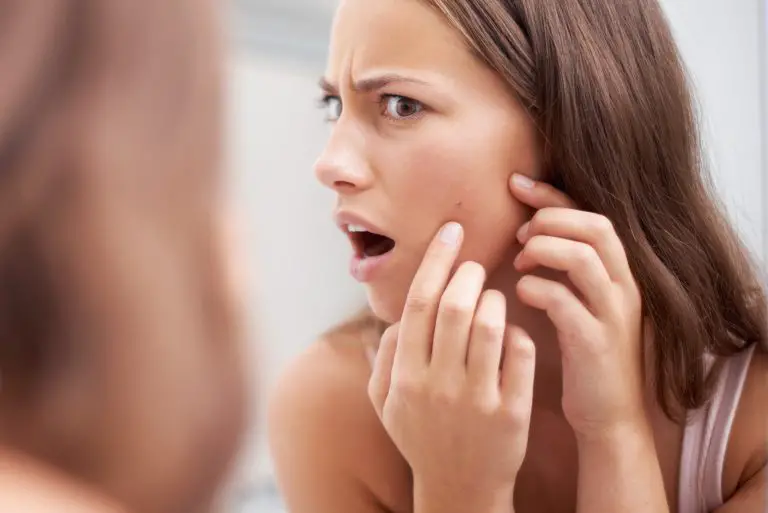You don’t have to be a professional makeup artist to be able to cover up acne, pimples, blackheads, whiteheads or any undesirable occurrences on your face. All it takes are a few simple steps to get the look of flawless skin.
What’s The Right Makeup?
If you’ve already got oily skin or acne-prone skin, you must go for oil-free makeup products.
Oil-Free Products
Check the ingredients in your makeup product and ensure water is the first ingredient. The cosmetics that don’t result in clogged pores are non-acnegenic or noncomedogenic makeup (these don’t interfere with acne meds). Cosmetics that are mineral-based absorb excess oil and mask any redness without causing skin irritation.
An oil-free primer helps keep the makeup in place, even on an inflamed zit. Lightweight primers go easy on oily skin and don’t irritate acne. A primer with SPF protection would be beneficial, particularly for scarred or hyperpigmented skin. Apply primer on your entire face to help keep your makeup on evenly and longer.
Concealer
A colour-correcting concealer would be a perfect choice; it uses hues to mask imperfections. The green concealer or flesh-toned concealer is for red blemishes, while the yellow concealer is for blackheads. Selecting a liquid concealer one or two shades lighter than your skin tone offers good coverage since oily skin oxidises the concealer. If you’re unable to find one that suits your skin tone, you could mix up two concealer shades.
Foundation
You could go for a cream foundation, liquid foundation, or a mineral powder foundation (that doesn’t clog the pores as much as a liquid foundation but provides less coverage). A stippling brush or makeup sponge must be used for applying foundation. A matte finish foundation absorbs excess oil and conceals the bumps on the skin.
You could get an oil-free tinted moisturiser that doesn’t clog pores or make your acne worse for light coverage. A full-coverage foundation that’s oil-free, fragrance-free, and non-pore clogging would be a perfect choice.
Setting Powder
Consider getting a setting powder if you’ve got oily skin. This translucent powder provides a matte finish to the skin sans extra colour and keeps the skin oil-free all day long.
Mineral makeup is another alternative to translucent powder; however, this must be avoided for skin types other than oily skin, since it can exacerbate dryness.
Apply Makeup The Right Way

To cover acne with makeup, there are a few steps for applying makeup effectively to cover acne with makeup.
1. Start With a Fresh Base
Your skin is the base for the makeup that you’re about to apply. It’s essential to cleanse your face with warm water, to remove any excess oil. Follow this by applying a light moisturiser, preferably fragrance-free and water-based.
If you’re outdoors and on the move for most of the day, it would help to apply a moisturizer-sunscreen combination. Ensure there are no harmful chemicals like PABA and benzophenone in your sunscreen.
2. Use Clean Applicators
One can’t be too careful when handling acne-prone skin. If you prefer not to touch your skin, you could use sponges or brushes to apply the makeup. But remember that acne can be caused by bacteria present on hands and the sponges or brushes.
To avoid your skin getting affected, wash and sanitise these applicators at least twice a week. Preferably, the brushes must be cleaned once you’re done applying your makeup.
3. Apply Primer
Once the moisturiser has been absorbed into the skin, the next step is to apply the primer with your fingers or a sponge. This ensures that the rest of your makeup can stay on your skin smooth all day long and not penetrate your skin.
You could lightly dab it on the problem spots if you merely intend to conceal dark spots or cover pimples. It would be best to wait for a few minutes for your primer to set in for a few minutes.
4. Use Concealer For Color Correcting
Apply concealer to the spots in an ‘X’ pattern or criss-cross by gently patting it, not rubbing. A green colour corrector is used to neutralise any redness, simply because green and red are opposite colours on the colour wheel, hence cancelling each other out; a yellow corrector disguises age spots or blackheads.
5. Apply Concealer Based On Your Skin Color
If there are any areas that you’d like to give extra coverage to, you could dot concealer over those areas. Too dark or too light concealers make the pimples show more evidently. It’s essential to use a concealer that matches your skin tones exactly. Gentle and light dabbing with a sponge will cover acne from all angles.
6. Apply Foundation
Use a stipple brush if you’re using liquid foundation around stippling motion for coverage without the concealer getting wiped off. Start with a little, and if it seems inadequate after the first application, keep adding a light layer until the result seems satisfying.
If spots show persistently after applying foundation, you could use a concealer again. However, green concealer mustn’t be applied after using foundation.
7. Use Setting Powder
After waiting for the foundation to set, you could use a large fluffy brush to apply the finely-milled loose powder or pressed powder in a stippling motion. This ensures your makeup stays on for the rest of the day while giving your skin a matte appearance. You must be careful not to use too much powder, though.
A Few Expert Tips
1. For pimples, tea tree oil, sulphur, and retinol treatments work as wondrous fixes.
2. You could use a cold or hot compress to soothe your skin and reduce inflammation. An ice cube soothes sore skin, while a warm face cloth helps kill bacteria.
3. A proper skincare routine is required to keep your face clean and avoid clogging of pores. You must remove all your makeup thoroughly before going to bed at night. Sleeping with your makeup can mix it with the dirt and oil that got built up on your skin’s surface, leading to clogged pores. Micellar water or makeup cleaning towelettes are good no-rinse options.
4. If your face has been annoyingly covered in red spots and acne, it would be best to seek an acne treatment to aid in the healing process. Consulting a dermatologist would help you decide on a suitable treatment.
Final Thoughts
Whether you have acne breakouts, a single annoyingly large pimple, or any other undesirable eruptions on your face, you don’t need makeup artists to help you cover it up. With the right makeup products and the right application techniques, you could cover up that acne all by yourself.

